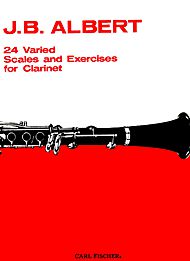Albert clarinet scales
The Albert clarinet scales also known as: J.B. Albert 24 Varied Scales and Exercises for Clarinet, published by Carl Fischer.

The Albert Scales Method is usually the first scale book I have students buy. It is not necessarily for beginners as all the scales are two octaves.
This book covers all 12 major clarinet scales followed by each relative melodic minor scale totaling 24 scales. It is organized by the circle of fourths.
C Major, a minor, F major, d minor, Bb major, g minor, Eb major, c minor, Ab major, f minor, Db major, Bb minor, Gb major, eb minor, B major, g# minor, E major, c# minor, A major, f# minor, D major, b minor, G major, e minor.
STRANGER THINGS Season 5 soon
Learn the Stranger Things Lick from
Half-Beard Guy
What can be any "stranger" than than learning a few things from a guy whose beard covers only half the face? Well, learn your D Major 7 broken chord from Chris here at Clarinet-Now.com and follow @ClarinetNow on Youtube to see the series of Stranger Things videos coming out Halloween week.
improve your Clarinet Speeds and Musicality from Bumblebee Loops. Follow these links to get to CAMco.
Every scale has a series of routines. This is how I recommend learning these scales based on your level.
ALBERT CLARINET SCALES LEVEL 1 - Clarinetist knows some major scales and how to cross the break.
Learn each major scale, 1st Staff on page. THIS IS THE BASIC SCALE.
Learn each major arpeggio in triplets, 7th staff on page.
ALBERT CLARINET SCALES LEVEL 2 - Clarinetist knows all major scales but wishes to improve them.
Practice each major scale, 1st Staff on page QUARTER NOTE = 108.
Practice the scales in fours, 4th staff on page QUARTER NOTE = 80.
Practice the triplet and broken arpeggios, 7th staff on page QUARTER NOTE = 72.
Practice the thirds, 6th staff on page QUARTER NOTE = 72.
Practice the chromatic scale on the bottom of the page at QUARTER NOTE = 108.
ALBERT CLARINET SCALES LEVEL 3 – Clarinetist has gone through the LEVEL 2 routines.
Practice all minor scale routines similar to LEVEL 2 with the same tempo markings. Practice the scale, scale in fours (4th staff), thirds (6th staff), arpeggios (7th staff), and chromatic scale (bottom staff).
Remember this is the melodic minor form of the minor scale. This means the 6th and 7th tone of the scale is each raised a half-step ascending, and then lowered to the natural minor form descending.
ALBERT CLARINET SCALES LEVEL 4 – Clarinetist has gone through LEVEL 2 and 3 routines.
Practice all major and minor scale routines on each page.
About Practicing These
Clarinet Scales
WHY SHOULD I LEARN SCALES? All Western music is based off the Major and Minor scales. It does not matter what style of music you want to learn (jazz, classical, rock, country, popular, Broadway, klezmer, etc…), you must know your scales for ultimate musical success. Your sight-reading will improve. You will win better chair placements and competitions (county, district, all-state) just by knowing your scales well.
Each level you pass (as described above) is a real accomplishment; here are a couple things to remember…
Practice all the scales or patterns very slowly until you’ve learned them well. Do not allow hiccups, restarts, wrong notes, etc…
Also, keep the scales as smooth as possible.
While I will assign one page per lesson, no matter what LEVEL, make sure you at least practice every major scale every day. To understand this, I will listen my student play every single major scale. Then, I’ll go to the Albert scale page and go through the routines for that particular scale.
Hopefully, if you’ve practice well during the week, you will mark off that scale and move to the routines of the next major scale.
GREAT ACCOMPLISHMENT: You have memorized at least the scale, fours, thirds, arpeggios (triplets and broken), and chromatic scale.
ULTIMATE ACCOMPLISHMENT: You memorized all of the routines for each scale.


